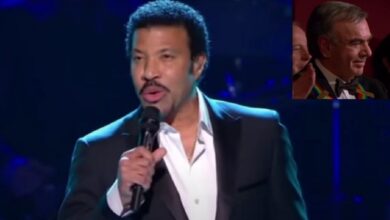Listening to Marty Haggard’s son sing his father’s song brings tears to our eyes
Merle Haggard, born in 1937 in Oildale, California, was a defining figure in the world of country music. He grew up in a poor family and faced numerous challenges during his childhood, including the early loss of his father, which left his mother to raise him and his siblings alone. These formative experiences significantly shaped his songwriting, infusing it with themes of hardship, resilience, and familial bonds. Haggard’s unique ability to articulate the struggles of the working class made him an iconic voice in country music, leading him to evolve from a troubled youth to an influential artist celebrated for his storytelling.
His song “Mama’s Hungry Eyes” is a profound reflection of these personal experiences. Written and recorded in 1968, the piece bleeds authenticity as it narrates the life of a mother whose love and sacrifices profoundly impacted her children. The lyrics serve as a window into the emotions tied to childhood memories and the stark realities of growing up in a challenging environment, where every little joy was at times overshadowed by struggles. It captures the essence of what it means to be resilient, illustrating how hard work and love can create a sense of belonging and purpose, despite the odds.
Haggard’s storytelling resonates on multiple levels, speaking not only to his own life but also to the lives of countless others who have experienced similar hardships. The song portrays a vivid image of a mother’s sacrifice and the tenderness of her love, emphasizing the way her struggles painted a picture of strength for her children. This sentiment echoes in the hearts of many listeners who find solace in the knowledge that they are not alone in their struggles; the song serves as a reminder of the unwavering bond between a mother and her children.
In revisiting “Mama’s Hungry Eyes,” Marty Haggard introduces additional complexity to the narrative with his version. His take not only honors his father’s work but also serves to elaborate on the stories of resilience witnessed in his family. By adding a new verse that describes his mother’s hard work at a truck stop, Marty paints a more in-depth picture of the life she led. This new layer encapsulates the dedication she had towards her family, further reminding listeners of the often hushed sacrifices that go unnoticed in the everyday hustle. The act of adding to this already poignant song is not only an acknowledgment of his upbringing but also a celebration of the enduring power of a mother’s influence.
The way both Merle and Marty Haggard approach this song highlights the evolving nature of musical storytelling in country music. While Merle lays down the foundational emotional narrative, Marty enriches it, demonstrating how personal experiences transcend time and can be revisited from different perspectives. Country music thrives on such relatability, where each story becomes a thread in the larger fabric of human experience, connecting listeners across generations.
The emotional appeal of “Mama’s Hungry Eyes” is not limited to its lyrical content. The melody is simple yet haunting, creating an atmosphere that complements the depth of the song’s message. The rawness of Haggard’s voice conveys a sense of sincerity that resonates deeply, evoking feelings of nostalgia and empathy. The harmonic elements within the song craft an experience for the listener that goes beyond mere words, creating a memorable musical moment that transcends its era.
As the years have gone by, “Mama’s Hungry Eyes” has maintained its relevance in country music culture. It has been covered and interpreted by many artists, proving that its themes are timeless and universal. The song’s exploration of familial love and sacrifice continues to resonate in modern society, where many face challenges akin to those described in the lyrics. The ability of the song to evoke such deep emotional responses speaks volumes about Haggard’s prowess as a songwriter and storyteller.
In addition to the song’s content, the Haggard family legacy itself is intertwined with the landscape of American country music. Merle’s contributions, including numerous chart-topping hits and awards, established him as a pillar in the industry, while his son Marty carries the torch forward with respect and admiration for his father’s work. This generational connection underscores a broader theme in country music, where personal histories and familial ties often serve as rich sources of inspiration and creativity.
The resonance of “Mama’s Hungry Eyes” can also be seen in its cultural adaptations over the years. Various artists have drawn upon its themes in their work, creating a dialogue about the experiences of mothers and the sacrifices they make for their families. It perpetuates the narrative of hard work and devotion, offering hope and understanding to those who may feel overlooked in their struggles.
In essence, “Mama’s Hungry Eyes” remains a quintessential example of storytelling in country music. It illustrates how deeply personal histories can resonate with a broad audience, capturing the essence of love, sacrifice, and resilience in ways that are both moving and necessary. As listeners continue to find meaning in its lyrics and melody, the song endures, reminding us all of the power of a mother’s love and the narratives that shape our lives. The legacy of both Merle and Marty Haggard ensures that such stories will continue to be told, cherished, and celebrated in the years to come.





